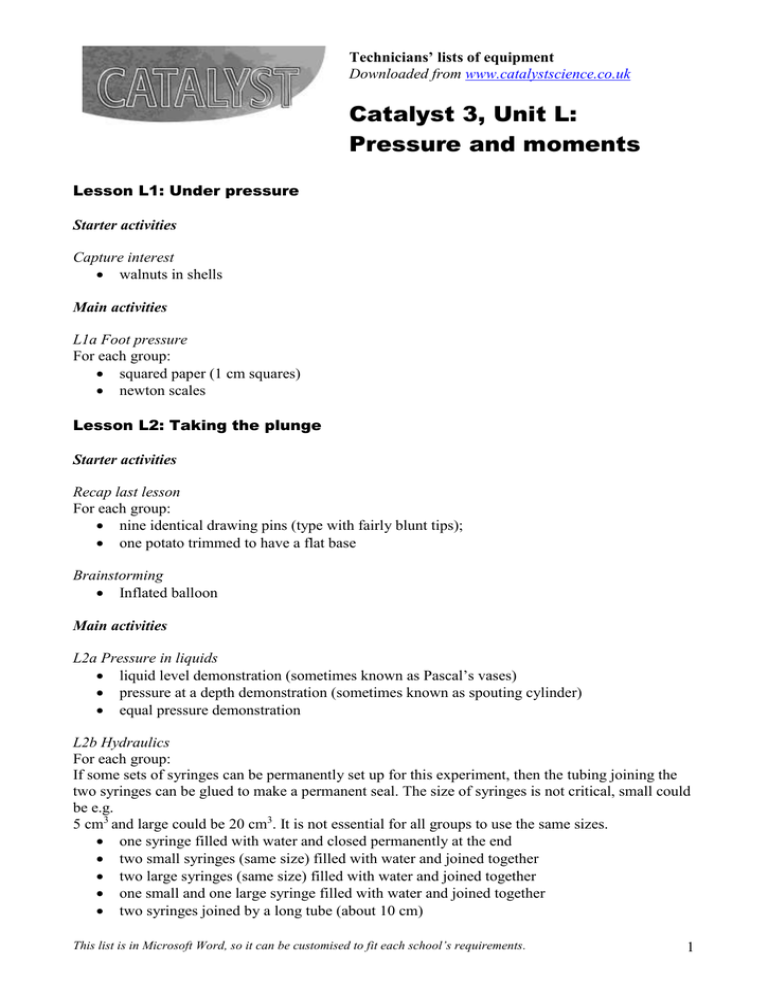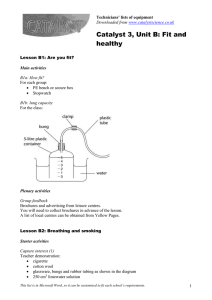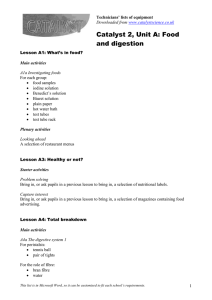Year 9 equipment list - Unit 3L: Pressure and moments (DOC, 117 KB)
advertisement

Technicians’ lists of equipment Downloaded from www.catalystscience.co.uk Catalyst 3, Unit L: Pressure and moments Lesson L1: Under pressure Starter activities Capture interest walnuts in shells Main activities L1a Foot pressure For each group: squared paper (1 cm squares) newton scales Lesson L2: Taking the plunge Starter activities Recap last lesson For each group: nine identical drawing pins (type with fairly blunt tips); one potato trimmed to have a flat base Brainstorming Inflated balloon Main activities L2a Pressure in liquids liquid level demonstration (sometimes known as Pascal’s vases) pressure at a depth demonstration (sometimes known as spouting cylinder) equal pressure demonstration L2b Hydraulics For each group: If some sets of syringes can be permanently set up for this experiment, then the tubing joining the two syringes can be glued to make a permanent seal. The size of syringes is not critical, small could be e.g. 5 cm3 and large could be 20 cm3. It is not essential for all groups to use the same sizes. one syringe filled with water and closed permanently at the end two small syringes (same size) filled with water and joined together two large syringes (same size) filled with water and joined together one small and one large syringe filled with water and joined together two syringes joined by a long tube (about 10 cm) This list is in Microsoft Word, so it can be customised to fit each school’s requirements. 1 Technicians’ lists of equipment Downloaded from www.catalystscience.co.uk Catalyst 3, Unit L: Pressure and moments Plenary activities Group feedback a spirit level Brainstorming scissors Lesson L3: Pressure in the air Starter activities Recap last lesson ‘pressure at depth’ and ‘equal pressure’ demonstrations (see Activity L2a) Problem solving helium balloon if available Capture interest (1) sink plunger method of attaching weights weights Capture interest (2) rotary pump or Bunsen burner and dry cloth for handling hot can; tin can with screw lid (can be supplied for experiment by Philip Harris) Main activities L3a Air pressure Access to the Internet if pupils are going to follow up demos with research. 1 The Magdeburg hemispheres: Magdeburg hemispheres rotary pump pressure tubing to connect 2 The collapsing can: (pump method; see Starter L3 for steam method) rotary pump can for experiment (e.g. Philip Harris) pressure tubing for connecting 3 The barometer: glass or clear plastic tube approximately 50 cm to 1 m in length closed at one end trough of water safe access to mercury barometer if available This list is in Microsoft Word, so it can be customised to fit each school’s requirements. 2 Technicians’ lists of equipment Downloaded from www.catalystscience.co.uk Catalyst 3, Unit L: Pressure and moments L3b The pressure is on! For each group: syringe of water with end closed off permanently syringe of air (same size) balloon (not inflated) Plenary activities Sharing responses a small plastic fizzy drink bottle with lid, with three holes drilled in the bottom the bottle is filled with water and the lid replaced Looking ahead a jar with a tightly fitting lid; a cloth jar opening tools if available a chain wrench or mole grips (some tool that increases leverage and enables you to open the jar) Lesson L4: Where’s the pivot? Starter activities Problem solving a rusty bolt to be undone; a hammer; several spanners that fit the bolt but have different length handles and/or a hollow metal tube which fits over a spanner to make the handle longer (a hollow metal tube is a convenient way to extend the length of the spanner provided for changing a car wheel, where the nuts are often difficult to undo) Main activities L4a Pivots and levers For each group (or arrange as a ‘circus’): limb or joint model. Models of joints are available to buy (but if you have none pupils can think about their elbow or knee joint). A moveable, not static, joint is needed. A complete limb or skeleton or animal joint would be OK. access to cupboard door access to tap a nut and bolt to undo and spanners of different lengths a tin to undo (e.g. large coffee tin) and screwdrivers of different lengths a pair of scissors, thick (almost impossible to cut) and thin card This list is in Microsoft Word, so it can be customised to fit each school’s requirements. 3 Technicians’ lists of equipment Downloaded from www.catalystscience.co.uk Catalyst 3, Unit L: Pressure and moments Plenary activities Share responses two felt-tip pens for each group in different colours Lesson L5: Balancing act Starter activities Recap last lesson a forcemeter that can be attached to door handle and which measures force in the range required to open the door Problem solving a simulated tightrope, e.g. a 5 cm × 5 cm × 2 m piece of wood Main activities L5b Balance For each group: a balance beam, e.g. a metre rule graduated with eight holes (equidistant) on each side. The centre of the beam is where the blunt round nail (for safety) is put through as a pivot. This is clamped to a stand with a boss. two hangers for masses three masses (two of 100 g and one of 200 g) Blu-Tack or something similar for balancing a beam if it is off centre. Plenary activities Review learning mechanical weighing scales such as kitchen scales Looking ahead Lego crane or similar Looking ahead (Teacher sheet) Lego set (or similar) Alternatively: crane model load Blu-Tack metal counterbalance opening bridge or barrier model This list is in Microsoft Word, so it can be customised to fit each school’s requirements. 4 Technicians’ lists of equipment Downloaded from www.catalystscience.co.uk Catalyst 3, Unit L: Pressure and moments Lesson L6: Moments in life Starter activities Recap last lesson beam balance hangers items to test including: two identical balloons, one inflated with air, one not, on identical thread a large feather and a small lead weight an air balloon and a helium balloon a piece of lead with a mass of perhaps 10 g Capture interest (1) toys that balance (see Teacher sheet) potato two forks glass 2p coin Blu-Tack Capture interest (2) fork scissors garden spade other unbreakable objects, preferably symmetrical as pupils can ignore one dimension and see what is happening more easily Problem solving Scissors rulers and some way of supporting rulers standing on their edge (e.g. Blu-Tack or mirror stands) string for suspending the animal two ducks already cut out with holes and string, one that goes beak down and one that goes tail down Plenary activities Group feedback scissors rulers and some way of supporting rulers standing their edge (e.g. Blu-Tack or mirror stands) string for suspending the animal This list is in Microsoft Word, so it can be customised to fit each school’s requirements. 5 Technicians’ lists of equipment Downloaded from www.catalystscience.co.uk Catalyst 3, Unit L: Pressure and moments Lesson L7: Getting balanced Starter activities Bridging to the unit model ‘seesaw’ with a ‘light’ and ‘heavy’ ‘child’ (could be a beam balance with two different masses) Setting the context beam balance Blu-Tack Concrete preparation (2) plank or beam of wood pivot; 1 kg bag of sugar large mass (several kg) ruler Main activities L7a Getting balanced For each group: a balance beam, e.g. a metre rule graduated with eight holes (equidistant) on each side. The centre of the beam is where the blunt round nail (for safety) is put through as a pivot. This is clamped to a stand with a boss. 10 × 1 N slotted weights and holder retort stand and clamps Blu-Tack or something similar for balancing the beam if it is off centre access to computers if pupils are to set up a spreadsheet for the results and subsequent calculations. This list is in Microsoft Word, so it can be customised to fit each school’s requirements. 6





